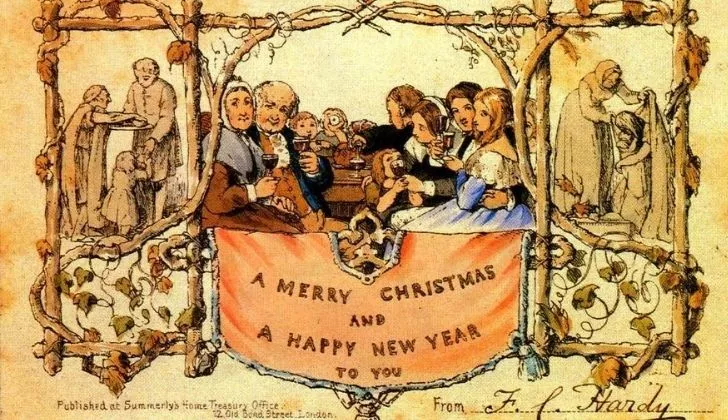The first ever Christmas card consisted of hand-drawn images of adults and kids raising their wine glasses for a toast.
The tradition of sending Christmas cards started in England in 1843. Prior to that, people used to send private notes to wish Merry Christmas, to congratulate on births and to wish a happy new year.
Sir Henry Cole, who was very busy, did not have time to write personal messages for Christmas in 1843. However, he did not want to skip sending cards altogether.
Therefore, he hired an artist named John Calcott Horsley to design a card that could be sent off instantly.
The First Christmas Card

The first Christmas card consisted of hand-drawn images of adults and kids raising their wine glasses for a toast.
It also had some religious symbols such as sprigs of holly, which symbolized chastity, and ivy, which symbolized places where God had walked.
The message below the picture was “A Merry Christmas and a Happy New Year to you.”
One thousand of these cards were printed and sold in a few stores in London. Only one of the original cards still exists today.
Two Reasons for the Popularity of Christmas Cards

The custom became popular because greetings could be mailed for a penny each in 1843, London.
Another reason is linked to a scandal related to Horsley’s design. A family surrounded by religious symbols with glasses of wine in their hands offended some people. The controversy is believed to have helped promote Cole’s idea.
Therefore, we send Christmas cards because it is a better way than writing personal notes to people. They look attractive, and it does not take much time to wish important people in our lives a Merry Christmas.
FAQ
1. What is the history behind sending Christmas cards?
The tradition of sending Christmas cards dates back to the mid-19th century in England when the first commercial Christmas cards were produced by Sir Henry Cole. These cards featured a festive design and a short message of holiday cheer. The popularity of sending Christmas cards grew quickly, and soon people all over the world were sending cards to their loved ones during the holiday season. Today, Christmas cards continue to be a popular way to connect with friends and family during the holidays.
2. Why do we still send physical Christmas cards in the age of technology?
While it’s true that many people send digital holiday greetings via email or social media, physical Christmas cards still hold a special place in many people’s hearts. A physical card can be displayed on a mantle or fridge as a reminder of the sender’s love and well-wishes. Additionally, some people prefer the personal touch of a handwritten message over a digital message. Finally, receiving a physical card in the mail can be a welcome break from the deluge of bills and junk mail that often fills our mailboxes.
3. What are some popular designs and themes for Christmas cards?
Christmas cards come in all shapes and sizes, and there are countless designs and themes to choose from. Some popular designs include traditional winter scenes, religious motifs, and whimsical illustrations of Santa Claus and his reindeer. Many people also choose to include family photos or personalized messages in their cards. Some popular themes for Christmas cards include peace, love, and joy, as well as gratitude and thankfulness for the blessings of the past year.
4. Are there any etiquette rules to follow when sending Christmas cards?
While there are no hard and fast rules when it comes to sending Christmas cards, there are a few etiquette guidelines to keep in mind. First, it’s important to address the card to the correct recipient and spell their name correctly. Additionally, it’s considered polite to include a short message of holiday cheer or a personalized note in the card. Finally, if you receive a Christmas card from someone, it’s generally expected that you will send a card in return. However, if you don’t have the time or resources to send cards to everyone on your list, it’s perfectly acceptable to focus on close friends and family members.

Zayn Anderson is a prolific writer with a passion for uncovering the world’s intriguing facts. Armed with an insatiable curiosity, he delves into various subjects, from history and science to nature and technology.
